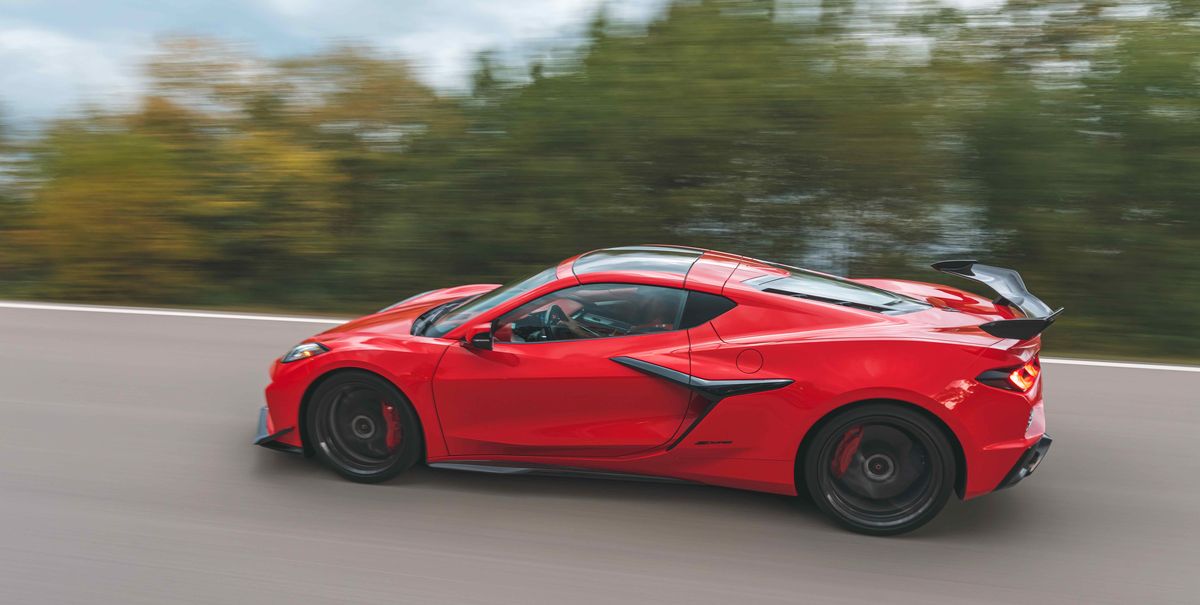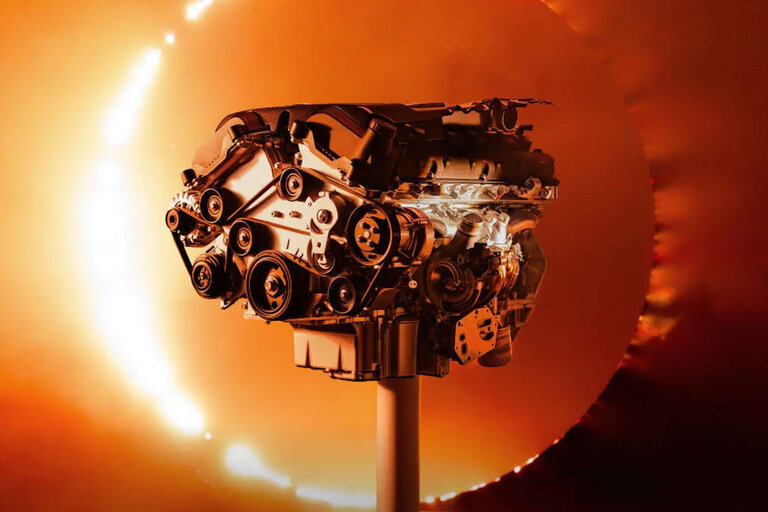
Marc UrbanoCar and Driver
The new 2023 Z06 is a special car, and making it so required a long list of engineering changes that ran, literally, from road to roof. Some of them are obvious to the naked eye, but many of them are below the surface. The Corvette engineering group has extensive experience developing standard models into higher-performance track assassins. Witness the three generations of Z06s—C5, C6, and C7—dating back to 2001. Here’s what they revised on the already impressive base C8 Stingray to transmogrify it into the intensely focused Z06.
Advertisement – Continue Reading Below
This new LT6 V-8, code-named Gemini, is the foundation around which the new Z06 was built. No Corvette before has had an all-new, bespoke powerplant with nothing shared with any other GM engine. And this one is special: a naturally aspirated double-overhead cam 32-valve flat-plane-crankshaft design inspired by the Ferrari 458 engine. It makes its power through ultra-high revs: its 670-hp peak hits at 8400 rpm; its 460 pound-feet of torque arrives at a soaring 6300 rpm; and it redlines at 8500 rpm. It exhales through a clever driver-adjustable exhaust system that can vary the engine music from mild to wild-thang. The engine is hand-assembled by a single engine builder at the Corvette assembly plant in Bowling Green, Kentucky.
With 180 more horsepower to deal with than what the base C8’s 6.2-liter V-8 produces, the Vette’s dual-clutch automatic transmission required some time in the gym. The transaxle case and bellhousing are stronger, the six-plate clutch is stouter, and the output shaft flanges are larger and bolt up to higher-strength half-shafts. One of the clutch packs gets an additional clutch plate. The internal lubrication system has been revised to handle higher cornering forces and doesn’t require filling with extra lubricant for track events. (The trans in the C8 Z51 track package model does.) The final enhancement is a 7 percent shorter final-drive ratio to help the high-revving engine get to its happy place even quicker.
Better Thermal Management
The Z06’s powerful V-8 generates much more heat than does the base C8’s engine. And the LT6 needs to run extra cool; the engineers discovered this was one of the secrets that enabled the small-diameter, low-friction main bearings in the Ferrari 458’s gem of an engine, a design element incorporated into the Z06 V-8. The base C8 has a total of three coolers, two for engine coolant located in the outboard ends of the front fascia and one in the right-side air intake to cool the oil. The Z06 is fitted with two additional coolers, one located in the center of the front fascia and a second in the left-hand body-side air intake. Stronger front fans increase the airflow by 50 percent; larger side air intakes flow 20 percent more air. Owners can pop off a cover on the front fascia to increase the center grille opening by 75 percent to feed even more air to the center radiator. The car also gets a 20 percent larger air conditioning compressor to keep the cabin cool on hot track days. Nice.
The C8’s open-top aluminum structure was designed from the outset to handle the higher cornering loads of the Z06 and Z07-equipped models. No structural reinforcements were necessary, nor changes to the suspension arms or other primary chassis components. Spring rates for the standard Z06 are up over the C8 Z51 by 30 percent, and bushing stiffness has been increased. The engineers say that the tauter springing keeps the edges of the ultra-wide tires more upright in cornering and also reduces body roll enough that the Z06 can get by with slightly smaller anti-roll bars than the C8 Z51. Moreover, the engineers said that increasing the ride frequency—the firmness of the suspension-and-tire system as a whole—was a cool move because it gave the car a quick-reacting, on-its-toes feel that matched the nervous energy of the LT6 V-8. The Z07’s springs are another 10 percent stiffer. All Z06s get magnetorheological (MR) dampers standard. Tire size goes up to 275/30ZR-20 in front and 345/25ZR-21 in the rear—up by 30 millimeters in front and 40 millimeters in the rear compared to the C8 Z51’s already wide rubber. The standard Z06 comes on Michelin Pilot Sport 4S tires. The Z07 car gets the latest Michelin Pilot Sport Cup 2 R track-attack rubber—which is about as close to a race tire as you can make a street tire and still have it be legal for the road. Optional carbon-fiber wheels sharpen the steering response so much that the steering rack had to be recalibrated to eliminate turn-in dartiness. During the extensive on-track development, the engineers discovered that the carbon wheels’ reduced rotational inertia improved lap times on a two-minute lap by 1.0 to 1.5 seconds.
What speeds up must slow down. So, all Z06s are equipped with massive Brembo six-piston front and four-piston rear brakes, with different caliper designs for steel and carbon-ceramic rotors. Standard Z06s run the steel rotors; carbon-ceramics are optional. All Z07-package cars get carbon-ceramics standard. Both brake packages are fully track-capable according to the Corvette engineers.
Not surprisingly for a mega-powerful track-focused weapon, the Z06’s aerodynamics have been enhanced to deliver more downforce, which improves both traction and stability. The standard Z06’s aero package looks relatively mundane but is plenty effective: it has a larger rear-deck wing than the C8 Z51 with a more pronounced wicker; a change under the nose increases front downforce; under-car ducts are added for additional rear-brake cooling; and a cover on the front fascia is deleted to improve engine cooling. The few changes work well, producing 362 pounds of downforce at 186 mph—should you ever go that fast. The Z07 gets the max-downforce setup, which is also available as an option on the base Z06. It incorporates a big rear-deck wing; a full front underwing under the front end; under-car strakes that channel air out the sides to help suck the car down; a larger front splitter; and dive planes at the front corners. The changes generate 734 pounds of downforce at 186 mph. Moreover, we think they broadcast the badass nature of this hot-rod Corvette.
Advertisement – Continue Reading Below
#Turn #Chevrolet #Corvette #Stingray #Z06
Source link





